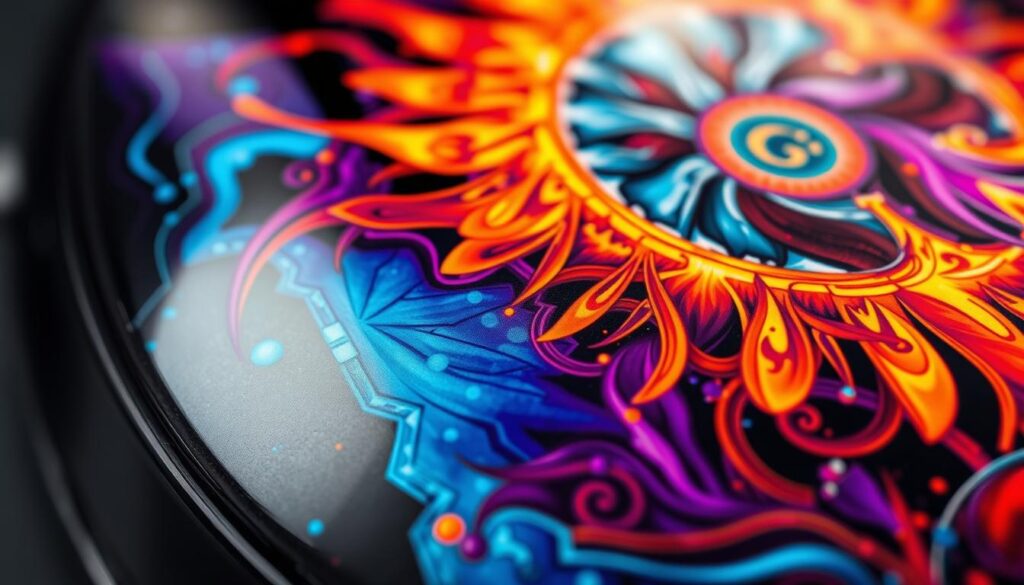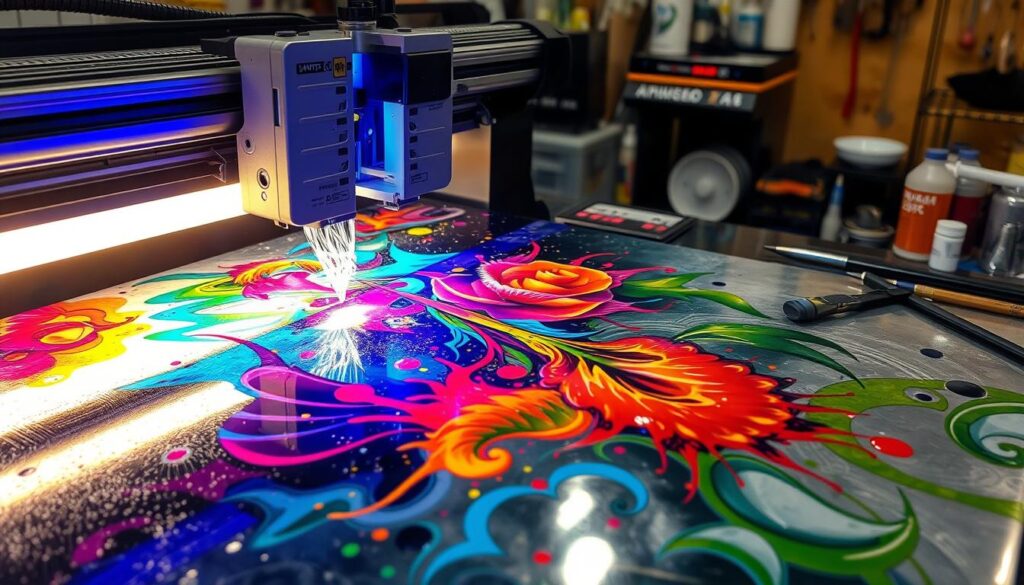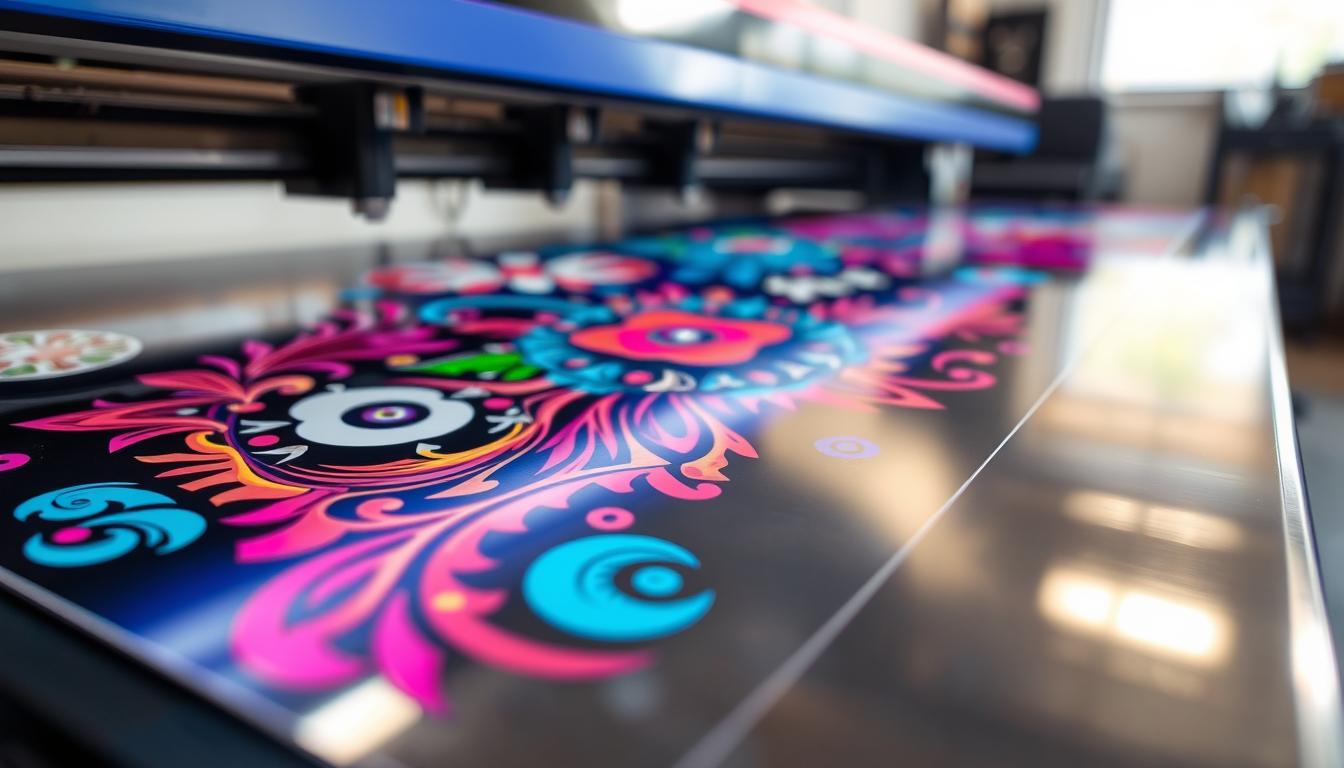UV digital printing is changing how we make artistic prints on iron. It uses UV-curable inks printed straight onto the metal. This results in bright colors, sharp graphics, and lasting quality.
UV printing on iron has many advantages. It creates a sleek, modern look with a high-definition finish. This finish is also resistant to fading, scratching, and moisture. It’s perfect for wall art, home decor, or custom apparel.
UV-cured inks let artists and designers create clear, precise prints on iron. It works well for many types of images, from black and white to full-color photos. This makes it great for unique and striking pieces.
Understanding UV Digital Printing Technology
UV digital printing uses ultraviolet (UV) light to instantly cure ink on various substrates. This includes metals like aluminum, stainless steel, copper, and brass. It’s a new way to print that’s better than old methods for making strong, quality prints on metal.
The Science Behind UV Curing Process
The UV curing process works through a photochemical reaction. This reaction hardens the ink without needing to evaporate. When UV light hits the ink, it quickly polymerizes, making the ink solid and sticking well to the surface.
This makes prints that don’t fade, scratch, or weather easily. They’re great for both inside and outside use.
Essential Equipment and Materials
- Flatbed UV printers: Specialized printers for printing on metals and other substrates for top-quality UV prints.
- UV-curable inks: These inks cure fast with UV light, giving bright colors and sticking well to metal.
- Primer applicator tools: These tools apply a primer for the best ink adhesion to metal.
- Curing lamps: These lamps give the UV light needed to cure the ink, making prints last long.
Benefits of UV-Curable Inks
UV-curable inks have many benefits for printing on metal. They dry instantly, cutting down on drying time and speeding up production. Their bright colors and resistance to fading and scratching keep designs looking good over time.
Also, these inks are better for the environment. They produce fewer harmful chemicals than traditional inks.

Digital UV Printing on Iron: Process and Applications
The digital UV printing on iron starts with preparing the design. This is done using special software to fit the metal’s unique surface. Then, the iron is cleaned and primed to help the UV inks stick well.
Next, the iron goes into the UV printer for high-resolution printing. The UV inks are made to last and look great. They are applied to the metal, creating bright, lasting graphics. A quality check ensures the image is perfect before it’s cured under UV light.
This method is great for many uses. It’s perfect for garment printing, on-demand printing of metal decor, and direct-to-garment printing for industry. It opens up endless ways to personalize iron products.
UV printing works well with digital workflows. It makes production fast, affordable, and high-quality. It’s ideal for custom clothes, metal signs, and industrial parts. The results are durable and look great for a long time.
Key Benefits of UV Printing on Iron
- Vibrant, high-resolution graphics with exceptional detail
- Durable, weather-resistant, and abrasion-resistant prints
- Versatile for a wide range of iron-based products and applications
- Enables on-demand printing and customization
- Cost-effective production process compared to traditional methods
- Environmentally friendly with minimal solvent use and waste
| Model | Print Area | Printing Speed | Recommended Application |
|---|---|---|---|
| KGT-1016 | 1000 x 1600 mm | 8-10 sq m/h | Aluminum sheets, stainless steel, metal signs, giftware items |
| KGT-2513 | 2500 x 1300 mm | 12-15 sq m/h | Metal plates, large metal sheets, industrial components |
| KGT-2033 | 2000 x 3300 mm | 15-18 sq m/h | Metal boxes, large metal panels, architectural metal elements |

Surface Preparation and Treatment Techniques
To get vibrant and lasting UV prints on iron, you need to prepare the surface well. Cleaning and priming are key to ensure the ink sticks and the print looks great. Whether you’re using iron-on transfers, print-on-demand, or digital textile printing, knowing how to treat the surface is vital.
Cleaning and Priming Metal Surfaces
First, clean the iron surface to get rid of dust, oils, or other stuff that might mess with the ink. A quick wipe with a damp cloth is a good start. For tougher dirt, use acetone on metal surfaces.
Then, prime the surface to make the ink stick better. Use a clear or varnish-based primer before printing. This is especially important for tricky surfaces like glass, which might need special treatments like flame or plasma.
Achieving Optimal Adhesion
- Scratch tests help check how well the ink sticks to iron surfaces.
- Techniques like sanding or laser etching can also boost adhesion on different materials.
- UV printing is fast, curing instantly, which cuts down production time by up to 40%.
Testing Surface Compatibility
Before starting big projects, test how well the surface and ink work together. This ensures your prints will last and look great, even after lots of use. By carefully preparing and testing the surface, you can make the most of UV printing on iron and create amazing designs.
Design Considerations for Metal Printing
Designers need to think about the special traits of print-on-demand tech when making designs for custom apparel printing or on-demand printing on metal. The shiny look of metals can change how colors appear, so picking the right colors is key.
Colors that are very bright look even more vivid on metal. Using contrasting colors can make designs clearer and more eye-catching. Designers should use software like Adobe Photoshop or CorelDRAW to get their designs ready for UV printing on metals.
It’s important to test and refine designs before making them on a large scale. This step helps make sure the design looks good on metal and spots any problems early. It’s a way to make sure the final product is both striking and effective.
| Metal Printing Substrates | Common Applications |
|---|---|
| Tinplate, Wuxi thin steel plate, zinc iron plate, black steel plate, aluminum plate, aluminum stamping container, aluminum and white iron composite materials | Container manufacturing, building materials, household electrical appliances, furniture, nameplates, miscellaneous supplies |
Metal surfaces can make printed images pop, making them great for print-on-demand projects. By understanding the special needs of metal printing and using the latest tech, designers can make metal products that really grab attention.
Color Management and Image Quality Optimization
Getting amazing results with UV LED printers on iron needs careful color management and image quality focus. Metallic surfaces, being reflective and changing color, require precise adjustments. This ensures the look you want.
Color Dynamics on Metallic Surfaces
Printing on iron means understanding color behavior on metal. It’s key to adjust color saturation, contrast, and vibrancy for metal’s reflective nature. Using software like Adobe Photoshop helps fine-tune colors, making your designs stand out.
Resolution and Detail Requirements
High-resolution images are vital for sharp, detailed prints on iron. Metal’s texture and reflection need detailed images. High-quality, high-resolution files are necessary to keep your designs clear during printing.
Software and File Preparation
Using the right software and file preparation is crucial for UV LED printing on iron. Programs like Adobe Photoshop have color management tools for metal printing. Proper file formatting and color adjustments ensure your designs look vibrant and high-quality on iron.

Leave a Reply